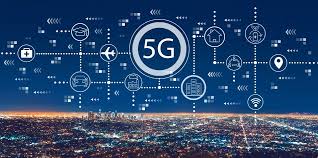The digital world is undergoing a massive transformation—and at the heart of this revolution lies 5G technology. Often described as the next big leap in mobile communication, 5G (fifth-generation wireless technology) is more than just faster internet on your phone. It’s a foundational technology that’s powering advancements in healthcare, transportation, manufacturing, smart cities, and more.
This blog explores how 5G is reshaping communication and unlocking new possibilities for industries and everyday life.
📡 What is 5G? A Quick Overview
5G is the successor to 4G LTE, offering:
- Higher Speeds – Up to 100x faster than 4G
- Lower Latency – As low as 1 millisecond (ideal for real-time applications)
- Greater Capacity – Supports 1 million devices per square kilometer
- Improved Reliability – More consistent connections in crowded areas
These features make 5G not just an evolution in mobile communication—but a revolution in connectivity.
🌍 The Evolution of Mobile Networks
Before diving into 5G’s impact, it’s helpful to understand how far we’ve come:
| Generation | Key Features | Use Cases |
|---|---|---|
| 1G | Analog voice only | Basic phone calls |
| 2G | Digital voice and SMS | Texting and clearer calls |
| 3G | Mobile internet and video calls | Browsing, mobile apps |
| 4G LTE | High-speed internet and HD video | Streaming, gaming, social media |
| 5G | Ultra-fast, low-latency, massive devices | Smart cities, VR, self-driving |
📞 How 5G is Transforming Communication
1. Faster, Clearer Voice and Video Calls
5G dramatically improves VoIP (Voice over IP) and video call quality. Buffering, lags, and call drops are minimized, even in high-traffic environments like stadiums or urban centers.
- HD and 4K video calls become standard
- Real-time translation and AR-enhanced communication possible
2. Immersive Experiences: AR and VR
Augmented Reality (AR) and Virtual Reality (VR) require low latency and high data rates—both strengths of 5G. Applications include:
- Virtual meetings with 3D avatars
- Remote training simulations
- Virtual tourism or real estate tours
3. Better Rural Connectivity
5G fixed wireless access (FWA) brings broadband to remote areas without needing extensive cable infrastructure—bridging the digital divide.
🏭 Beyond Communication: Industry Transformations with 5G
🚗 1. Autonomous Vehicles
Self-driving cars need to make split-second decisions based on real-time data. 5G enables:
- Vehicle-to-vehicle (V2V) and vehicle-to-infrastructure (V2I) communication
- Traffic coordination to avoid congestion and accidents
- Remote control in critical situations
🏥 2. Healthcare
5G enhances telemedicine, making remote diagnostics and treatment more effective:
- Real-time video consultations with zero lag
- Remote surgeries using robotic arms
- Smart wearable devices for continuous health monitoring
🏙️ 3. Smart Cities
Smart city infrastructure relies on thousands of connected sensors. 5G powers:
- Smart traffic lights and parking systems
- Waste management and environmental monitoring
- Emergency response coordination
🏗️ 4. Manufacturing (Industry 4.0)
Factories are getting smarter with 5G-enabled automation:
- Real-time monitoring of machines
- Automated guided vehicles (AGVs) for logistics
- Predictive maintenance using IoT sensors
🎮 Entertainment and Gaming
5G is changing how we consume content and play:
- Cloud gaming (e.g., Xbox Cloud, NVIDIA GeForce NOW) allows console-level games on smartphones.
- Live event streaming in 4K/8K without buffering.
- Augmented reality games in public spaces with minimal lag.
📈 Business and Economy
According to the World Economic Forum, 5G could add $1.3 trillion to global GDP by 2030. Small and large enterprises benefit from:
- Remote work infrastructure
- Enhanced customer experience through AI/AR
- Seamless IoT integration
⚠️ Challenges and Concerns
While 5G holds enormous promise, it comes with challenges:
1. Infrastructure Requirements
5G uses high-frequency waves that travel shorter distances, requiring:
- More cell towers
- Small cell installations on buildings, poles, and urban furniture
2. Cost of Deployment
Building nationwide 5G networks involves billions in investment, especially in developing countries.
3. Security Risks
With more connected devices, the attack surface increases:
- IoT devices are often vulnerable
- Need for end-to-end encryption and stronger protocols
- National security concerns around equipment vendors
4. Health and Environmental Myths
There’s public concern about radiation from 5G towers. However, leading health organizations, including the WHO, have found no evidence that 5G is harmful to human health when within regulatory limits.
🔮 What’s Next for 5G and Beyond?
- 5G-Advanced (Rel 18): Expected by 2026, offering even more intelligent, efficient networking.
- 6G: Already in early R&D stages, promising speeds 100x faster than 5G and enabling brain-computer interfaces.
- Private 5G Networks: Enterprises will set up their own 5G systems for secure, high-performance connectivity.
- Satellite-5G Integration: For global coverage, combining satellite internet (like Starlink) with terrestrial 5G.
✅ Tips to Prepare for the 5G Era
- Upgrade Devices: Ensure your smartphone or modem is 5G-compatible.
- Secure Your Connections: Use VPNs and update device firmware regularly.
- Watch Data Usage: Faster speeds can mean faster consumption—monitor your plan.
- Embrace Innovation: Expect apps, services, and tools designed specifically for 5G.
🧠 Conclusion
5G is not just a technology upgrade—it’s a digital revolution. It promises to make our communication faster and more immersive, while unlocking new capabilities in sectors like healthcare, education, industry, and transportation.
As 5G rolls out globally, it will reshape our lives in ways we’re only beginning to imagine. From self-driving cars to remote surgeries and AI-powered cities, the future is being written in 5G—and it’s arriving faster than ever.



